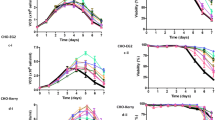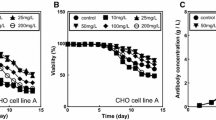Abstract
The monoclonal antibody productivity of cell culture systems is strongly dependent on the maintenance of hybridoma cell viability. We report that partial (<50%) and transient (3 h) inhibition of protein synthesis by cycloheximide or deprivation of an essential amino acid induces apoptosis (programmed cell death) in B cell hybridomas. This unusual mechanism of apoptosis induction is likely to play a significant role in limiting cell viability in batch and perfusion cultures of hybridomas and emphasizes the importance of constantly maintaining a near optimal rate of macromolecular synthesis by optimization of all culture parameters. Inhibition of apoptosis in hybridomas by cell engineering and other technologies should permit, in the near future, a significant increase in the antibody productivity of existing cell culture systems.
Similar content being viewed by others
Abbreviations
- CHX:
-
cycloheximide
- EDTA:
-
ethylenediaminetetraacetic acid
- FBS:
-
fetal bovine serum
- MEM:
-
minimum essential medium
- PBS:
-
phosphate buffered saline
References
Backer MP, Metzger LS, Slaber PL, Nevitt KL and Boder GB (1988) Large scale production of monoclonal antibodies in suspension culture. Biotechnol. Bioeng. 32: 993–1000.
Brüne B, Hartzel P, Nicotera P and Orrenius S (1991) Spermine prevents endonuclease activation and apoptosis in thymocytes. Exp. Cell. Res. 195: 323–329.
Carlsson R, Glad C and Borreback CKA (1989) Monoclonal antibodies into the '90: The all-purpose tool. Biotechnology 7: 567–573.
Cohen JJ and Duke RC (1984) Glucocorticoid activation of calcium-dependent endonuclease in thymocyte nuclei leads to cell death. J. Immunol. 132: 39–42.
Cohen JJ (1991) Programmed cell death in the immune system. Adv. Immunol. 50: 55–85.
De la Broise D, Noiseux M, Lemieux R and Massie B (1991) Long-term perfusion culture of hybridoma: “A grow or die” cell cycle system. Biotechnol. Bioeng. 38: 781–787.
De la Broise D, Noiseux M, Massie B and Lemieux R (1992) Hybridoma perfusion systems: A comparative study. Biotechnol. Bioeng. 40: 25–32.
Duval C, Demangel C, Geahel I, Blondeau K and Marcadet AJ (1990) Comparaison of various methods for monitoring hybridoma cell proliferation. J. Immunol. Meth. 134: 177–185.
Duval D, Demangel C, Munier-Jolan K, Miossec S and Geahel I (1991) Factors controlling cell proliferation and antibody production in mouse hybridoma cells: 1. Influence of the amino acid supply. Biotechnol. Bioeng. 38: 561–570.
Evan GI, Wyllie AH, Gilbert CS, Littlewood TD, Lard H, Brooks M, Waters CM, Penn LK and Hancock DC (1992) Induction of apoptosis in fibroblasts by c-myc protein. Cell 69: 119–128.
Franek F, Vomastek T and Dolnikava J (1992) Fragmented DNA and apoptotic bodies document the programmed way of cell death in hybridoma cultures. Cytotechnology 9: 117–123
Geaugey V, Duval D, Geahel I, Marc A and Engasser JH (1989) Influence of amino acids on hybridoma cell viability and antibody secretion. Cytotechnology 2: 119–124.
Golstein P, Ojcius DM and Young JDE (1991) Cell death mechanisms and the immune system. Immunol. Rev. 121: 29–65.
Hockenbery D, Nunez C, Milliman RD, Schreiber R and Korsmeyer SJ (1990) Bcl-2 is an inner mitochondrial membrane protein that blocks programmed cell death. Nature 348: 334–336.
Koury MJ (1992) Programmed cell death (apoptosis) in hematopoiesis. Int. Soc. Exp. Hematol. 20: 391–394.
Marcu KB, Bossone SA and Patel AJ (1992) Myc Function and regulation. Ann. Rev. Biochem. 61: 809–860.
Martel F, Bazin R, Verrette S and Lemieux R (1988) Characterization of higher avidity monoclonal antibodies produced by murine B-cell hydridoma variants selected for increased antigen binding of membrane Ig. J. Immunol. 141: 1624–1629.
Martin SJ, Lennon SV, Bonham AM and Colter TG (1990) Induction of apoptosis (programmed cell death) in leukemic HL-60 cells by inhibition of RNA or protein synthesis. J. Immunol. 145: 1859–1862.
McCall CA and Cohen JJ (1991) Programmed cell death in terminally differentiating keratinocytes: Role of endogenous endonuclease. J. Invest. Dermatol. 97: 114.
McConkey DJ, Hartzel P, Nicotera P and Orrenius S (1989) Calcium-activated DNA fragmentation kills immature thymocytes. FASEB J. 3: 1843–1849.
Miller WM, Blanch HW and Wilke CR (1988) A kinetic analysis of hybridoma growth and metabolism in batch and continuous suspension culture: Effect of nutrient concentration, dilution rate and pH. Biotechnol. Bioeng. 32: 947–965.
Perreault J and Lemieux R (1993) Rapid apoptotic cell death of B-cell hybridomas in absence of gene expression. J. Cell. Physiol. 156: 286–293.
Randerson DH (1985) Large scale cultivation of hybridoma cells. J. Biotechnol. 2: 241–255.
Smith CA, Williams GT, Kingston R, Jenkinson EJ and Owen JJT (1989) Antibodies to CD3/T-cell receptor complex induced death by apoptosis in immature T cells in thymic cultures. Nature 387: 181–184.
Vaughan MH Jr, Pawlowski PJ and Forchhammer J (1971) Regulation of protein synthesis initiation in HeLa cells deprived of single essential amino acids. Proc. Natl. Acad. Sci. USA. 68: 2057–2061.
Vomastek T and Franek F (1993) Kinetics of the development of spontaneous apoptosis in B cell hybridoma cultures. Immunol. Lett. 35: 19–24.
Wyllie AH, Kerr JFR and Currie AR (1980) Cell death: The significance of apoptosis. Int. Rev. Cytol. 68: 251–306.
Author information
Authors and Affiliations
Rights and permissions
About this article
Cite this article
Perreault, J., Lemieux, R. Essential role of optimal protein synthesis in preventing the apoptotic death of cultured B cell hybridomas. Cytotechnology 13, 99–105 (1993). https://doi.org/10.1007/BF00749936
Received:
Accepted:
Issue Date:
DOI: https://doi.org/10.1007/BF00749936




